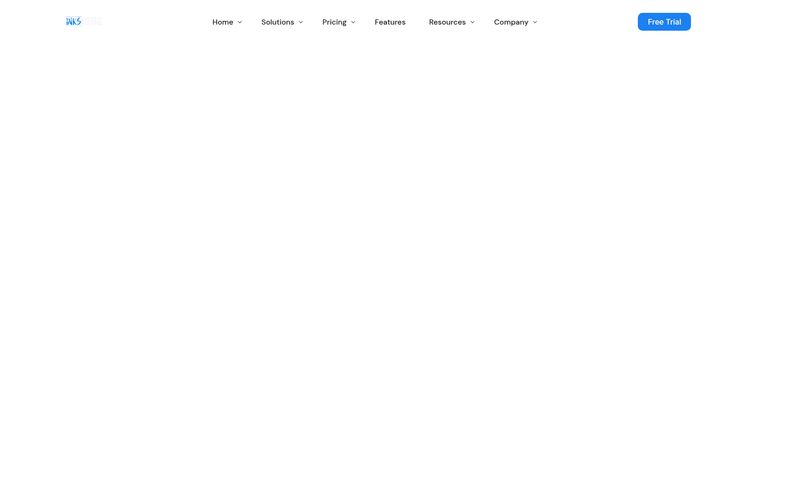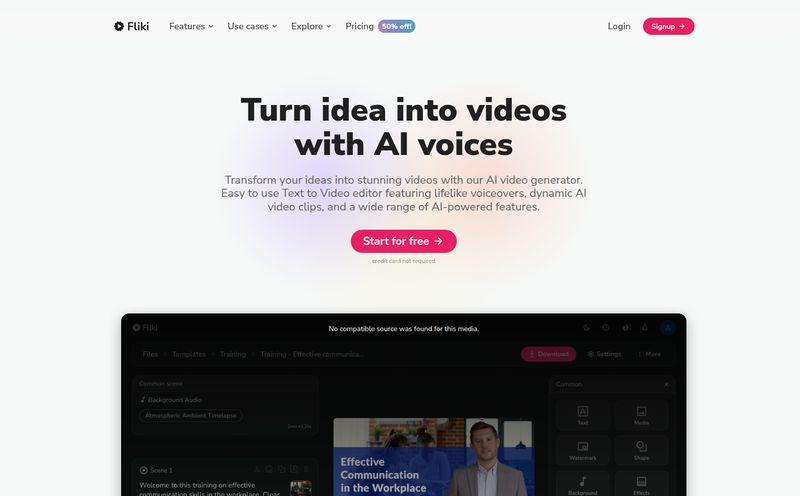As someone who’s been neck-deep in SEO and traffic generation for years, I'm always on the hunt for the next big thing that gives creators an edge. We all know video is king, but the kingdom is getting bigger. We’re not just talking to our local audience anymore; the goal is global. That means breaking the language barrier. It's a huge hurdle, and honestly, traditional dubbing is expensive and often... well, it sounds like bad kung fu movie dubbing from the 80s.
So, I've been keeping my ear to the ground for AI solutions. The other day, a name popped onto my radar: DubVid. The promise? AI-powered video translation with voice cloning and lip-syncing. My curiosity was officially piqued. This could be a game-changer for so many of my clients, and heck, for my own content too.
I grabbed my coffee, sat down at my desk, and navigated to their site to check it out. And I was greeted with... a 404 Not Found page. Yup. A big ol' error. Not the welcome party I was expecting. But you know what? In a weird way, it made me more interested. Is this a new tool that hit a snag? A platform in the middle of a massive update? It adds a little mystery to the mix. Despite the digital tumbleweed, I had already done some digging. So let’s talk about what DubVid is supposed to be, once it’s back from its little vacation.
So, What's the Big Idea Behind DubVid?
Putting the current website woes aside, the concept of DubVid is pretty exciting. Imagine you’ve just filmed a brilliant tutorial video. It’s clear, engaging, and your audience loves it. But your audience is primarily English-speaking. What if you could, with a few clicks, have that same video, in your own voice, speaking fluent Spanish, German, or Japanese? That’s the core promise of DubVid.
It's an AI platform designed to take your video content and translate it into over 25 different languages. But it's not just about slapping some subtitles on there (though subtitles are great for SEO!). DubVid aims to create a fully localized experience through a trio of impressive-sounding features. It's like having a personal UN translator on staff, one who’s been studying your voice for years.
The Tech That Makes It Tick
This isn't just a simple file conversion. The magic is in the details. From what I've gathered, the platform is built on a few key pillars that set it apart from basic translation software.
AI Translation with Natural-Sounding Dubbing
First up is the main event: the translation itself. The platform uses AI to translate your video's script into another language. But the key here is the natural dubbing. We’ve all heard robotic, monotone AI voices. They're fine for a GPS, but for a marketing video or an educational course? They can kill engagement instantly. DubVid's goal is to produce a voiceover that has a natural cadence and flow, making the content feel native to the new language.
Your Voice, But in French? The Wonder of Voice Cloning
This is the feature that really gets my inner nerd excited. Voice cloning. The platform can supposedly analyze your voice from the original video and then generate the translated audio in a synthetic version of your own voice. Think about that for a second. Your brand, your personality, your unique vocal signature remains consistent, no matter the language. For YouTubers and personal brands, that’s huge. It maintains the personal connection with the audience, which is incredibly difficult to do with a generic voice actor.
Avoiding the Uncanny Valley with Automatic Lip-Sync
Ever watch a dubbed film where the words are totally out of sync with the actor's mouth? It's distracting, right? It immediately breaks the illusion. DubVid tries to solve this with automatic lip-syncing. The AI adjusts the speaker's lip movements in the video to better match the new, translated audio. It's an ambitious feature, and I'll be honest, a very difficult technical problem to solve perfectly. But even a decent attempt at this can make a translated video feel ten times more professional.
A Painless Workflow with Direct Uploads
Convenience is a feature in itself. For busy content creators, the last thing you want is a complicated process. DubVid seems to get this, offering direct uploads from your computer, Google Drive, or even straight from a YouTube link. This streamlines the whole process, cutting out a bunch of tedious download/re-upload steps. I appreciate that. A lot.
The Good, The Bad, and The Unavailable
No tool is a silver bullet, and a healthy dose of skepticism is always a good thing in our line of work. Based on the specs, here's my take on where DubVid likely shines, and where it might stumble.

Visit DubVid
The Bright Side of Global Reach
The biggest pro is obvious: breaking into new markets. The ability to quickly and (presumably) affordably translate a marketing campaign or a whole library of YouTube content is massive. The voice cloning maintains brand authenticity, and the simple upload process means you're not wasting days on the technical side of things. It's built for scale. You could potentially double or triple your addressable audience without having to re-shoot a single frame of video.
Some Honest Limitations to Consider
Now for the reality check. The information I found suggests DubVid works best for single-speaker videos. This makes sense. AI would have a tough time distinguishing between multiple speakers, handling cross-talk, and cloning several different voices at once. So, for interviews or panel discussions, it might not be the right fit.
Also, the quality of both the voice cloning and lip-syncing can be a bit of a mixed bag. The final output is almost certainly dependent on the quality of your original video and audio. A clean, crisp recording with a clear voice will give the AI a much better chance of success than a noisy video shot on a windy day. It's the classic 'garbage in, garbage out' principle. The lip-sync, while a fantastic idea, probably isn't movie-magic perfect just yet. But for most online content, it doesn’t need to be perfect, just good enough not to be distracting.
The Million-Dollar Question: What Does DubVid Cost?
And here we are, back at the start. I was all ready to analyze their pricing tiers, compare value, and give you the full scoop. I clicked on their pricing page link, and... well, you know the rest. The 404 error means that for now, the pricing is a complete mystery. Is it a subscription? A pay-per-minute model? Is there a free trial? I have no idea.
This could mean anything. Maybe they're revamping their plans. Maybe the site is just temporarily down for maintenance. Whatever the reason, it's a bit of a bummer. I'll be keeping an eye on it, and you can bet I'll update this article the second I get my hands on that information.
Who Should Keep DubVid on Their Radar?
Even with the website issues and the unanswered pricing questions, the potential of this tool is clear. I see a few key groups who should be very interested:
- YouTube Creators: Imagine your tech reviews, travel vlogs, or commentary channels reaching audiences in India, Brazil, and Germany in your own voice. The potential for audience growth is staggering.
- Digital Marketers: Deploying video ads and social media content across different regions becomes so much easier. You can A/B test markets that were previously out of reach.
- E-learning and Course Creators: Selling your online courses globally is the dream. This could make it a reality, allowing students from around the world to learn from you directly, without the disconnect of a random voiceover.
- Corporate Trainers: Creating onboarding and training materials for a multinational company? A tool like this could save a fortune in localization costs and ensure a consistent training experience for all employees.
My Final Thoughts on DubVid (For Now)
So, what's the verdict? DubVid is a fascinating, ambitious platform that is tapping into a very real need in the content creation world. The promise of combining AI translation with personal voice cloning and lip-syncing is incredibly powerful. It represents a future where language is no longer a barrier to communication and connection.
Yes, the website being down is a hiccup. A pretty big one. And yes, there are limitations to the technology as it stands today. It's not magic. But it doesn't have to be. For the right kind of content—clear, single-speaker videos—it has the potential to be a revolutionary tool for expanding your reach. I'm choosing to be optimistic and see the 404 page not as a failure, but as a sign of a work in progress. A tool with this much potential is worth waiting for. I’ll be watching, and I’ll let you know when the doors are open again.
Frequently Asked Questions
- What exactly is DubVid?
- DubVid is an AI-powered platform designed to translate video content into over 25 languages. It uses features like natural-sounding dubbing, voice cloning to mimic the original speaker's voice, and automatic lip-syncing to create a fully localized video experience.
- How many languages does DubVid support?
- The platform supports translation into more than 25 languages, aiming to give content creators broad access to global audiences.
- Does DubVid actually use my own voice for the translation?
- Not your actual voice, but it does something arguably cooler. It uses AI to analyze your voice and then generates a synthetic version of it that can speak the new language. This helps maintain the personality and branding of your original content.
- What kinds of videos work best with DubVid?
- Based on its technical capabilities, DubVid is optimized for videos that feature a single, clear speaker. Think vlogs, educational tutorials, product demos, or corporate presentations. It may struggle with videos that have multiple speakers or a lot of background noise.
- Is the lip-syncing feature perfect?
- Lip-syncing is a very complex technology. While DubVid includes it to improve viewer experience, you should expect it to be a significant improvement over no-sync, but perhaps not flawlessly perfect in every single frame. The goal is to make it look natural and not distracting.
- Where can I find information on DubVid's pricing?
- Currently, that information is unavailable. As of this writing, the platform's website, including its pricing page, is showing a "404 Not Found" error. We will update this as soon as the information becomes public.



